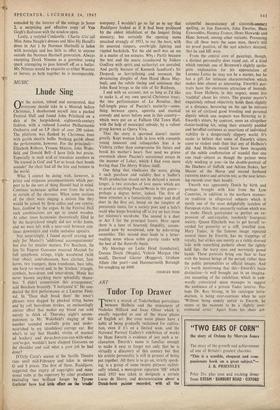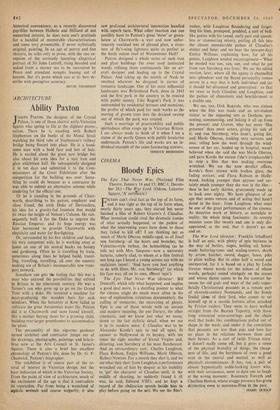ART
Tudor Top Drawer
THERE'S a stretch of Tudorbethan portraiture between Holbein and the miniatures of Nicholas Hilliard and Isaac Oliver which is usually regarded as one of the waste places of English art. But even waste places have a habit of being gradually reclaimed for cultiva- tion, even if it's on a limited scale, and the National Portrait Gallery's exhibition of works by Hans Eworth is evidence of just such a re- clamation. Eworth's name is familiar enough to make it easy to forget not only that he is virtually a discovery of this century but that his artistic personality is still in process of being put together. All there is to go on, strictly speak- ing, is a group of some twenty pictures stylisti- cally related, a monogram signature 'HE' which until 1913 was taken to designate a certain Lucas de Heere, and documentation about a Dutch-born painter recorded, with all the colourful inconsistency of sixteenth-century spelling, as Jan Eewowts, John Ewottes, Hans
Eywooddes, Haunce Evance, Hewe Hawarde and Hanc Seward, among other variants. Presuming that all these were the same man, there's still no proof positive, of the sort scholars demand, that he and HE were.
From the central core of paintings, though, - a distinct personality does stand out, of a kind which reminds one of Berenson's slightly apolo- getic explanation for his appreciation of Lorenzo Lotto; he may not be a master, but he has a gift for intimate characterisation which makes him almost as interesting. Eworth's por- traits have the enormous attraction of immedi-
acy. Even Holbein, in this respect, seems less `truthful' about his sitters. The greater master's exquisitely refined objectivity holds them slightly at a distance, bestowing on the age he mirrors an air of civilised good breeding and personal dignity which one suspects was flattering to it. Eworth's sitters, by contrast, seem an altogether .foxier-looking lot, using their ornately padded and beruffed costumes as assertions of individual stability in a dangerously slippery world. It's easier to believe that some of Eworth's sitters came to violent ends than that any of Holbein's did. And Holbein would have been incapable of the subtle confirmation of scandal that one can read—almost as though the painter were
slyly winking at you—in the double-portrait of the Duchess of Suffolk and Adrian Stokes, her Master of the Horse and second husband (AETATIS mom and AETATIS xxr, as the neat letter- ing records over their heads).
Eworth was apparently Dutch by birth and perhaps brought with him from the Low Countries, in addition to the northern manner- ist tradition in allegorical subjects which is surely one of the most delightfully tasteless of European styles, that oncourtly realism which was to make Dutch portraiture so perfect an ex- pression of anti-royalist, resolutely' bourgeois society. Queen Elizabeth was to get herself re- corded for posterity as a stiff, jewelled icon. Mary Tudor, in the famous image repeated several times by Eworth, has no trappings of
royalty, but strikes one merely as a richly dressed lady with something pathetic about the- tightly
held lips, the wary eyes and nervously posed hands. These portraits bring one face to face with the human beings of the period, rather than the public personalities or official images. And it's worth mentioning that this—Eworth's main distinction—is well brought out in an imagina- tive mounting of the exhibition, which in awk- wardly constricted space manages to suggest the ambience of a private Tudor interior. Per- haps Dr. Roy Strong, in his catalogue intro- duction, is being over-cautious when he says `Without being unduly unfair to Eworth, he seems at the moment to be a slightly over- estimated artist.' Apart from his sheer art- historical convenience, as a recently discovered gap-filler between Holbein and Hilliard of not unmerited interest, he does earn one's gratitude for a handful of memorable characterisations and some very presentable, if never stylistically original, painting. In an age of poetry and fine rhetoric, he talks only in prose, with the one ex- ception of the curiously haunting allegorical portrait of Sir John Luttrell, rising bearded and naked from a stormy sea to be succoured by Peace and attendant nymphs leaning out of heaven. But it's prose which can at its best de- scribe with perceptive accuracy.
DAVID THOMPSON































 Previous page
Previous page